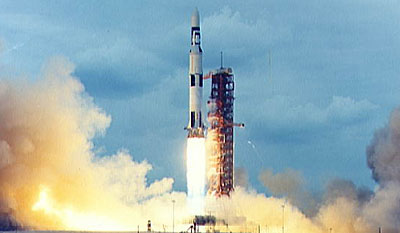Giant bombs on giant rockets: Project Icarusby Dwayne A. Day
|
| Sandorff posed a simple challenge: You have fifteen months. How do you stop Icarus? |
MIT was then deeply involved in the Apollo program. The guidance system for the Apollo spacecraft was developed there and the country’s foremost experts in aviation and space walked the school’s halls. Sandorff’s proposal was intended to teach his students how to improvise under pressure.
The class immediately split up into several working groups based upon their areas of expertise: orbits and trajectories, boosters and propulsion, spacecraft, guidance and control, communications, economics and management, and nuclear payloads. They began evaluating the different options for defeating the killer rock.
Could they launch a big bomb to the asteroid and blow it to pieces? Quick calculations showed that pulverizing a rock the size of Icarus would require a 1,000 megaton bomb. No nuclear weapon even remotely that big had ever been theorized, let alone designed or built. There was no way it could be done in the short time available. Using a bunch of smaller bombs was also not possible because they would all have to be detonated at exactly the same time. Otherwise, one bomb would vaporize the others before they detonated.
Fast intercept
The most desirable option would be to rendezvous with Icarus when it reached aphelion—the slowest point in its orbit—in November 1967. At that point it would be easiest to rendezvous with the asteroid and easiest to exert force to change its orbit. But such a mission would have had to be launched immediately, in spring 1967, and so it was out of the question. The group quickly determined that no rockets could conceivably be readied before 1968 and this greatly constrained their options. A slow rendezvous, or even a soft landing, was totally out of the question: Icarus would be moving too fast by 1968 for a spacecraft to reach it and then reverse direction for a rendezvous.
The only option was a fast intercept—fly out to Icarus and detonate a bomb near the surface to change its course.
The best way to get the most payload to Icarus was to launch two modified Saturn V rockets into orbit. These would rendezvous with an Apollo “space tug” launched atop a Titan III rocket. The space tug would connect up the modified S-IVB third stages from the Saturns. They would then be used to push a relatively large spacecraft out to Icarus where it would detonate a large nuclear weapon.
But there were many problems with this proposal. The Saturn S-IVB third stages were not designed to carry fuel in orbit for more than six hours and would require extensive modification. A spacecraft would also have to be designed form scratch and built in under a year. Most importantly, the on-orbit operations required to link up the large craft were extensive and unproven. There would be no way to practice. This plan was rejected.
What the group decided to do was to take six Saturn V rockets then in production, and with only minimal modifications to their payloads use them to carry smaller bombs to Icarus. The first launch would have to take place by April 1968, only a year away, and five more launches would have to follow at two-week increments.
| In profile, the Icarus Saturn V would have looked much like the Skylab launch vehicle lofted by the Saturn V in 1973, although slightly shorter. |
The actual Icarus spacecraft would have consisted of an Apollo Service Module (SM) with a five-foot cylindrical extension known as the Payload Module (PM) at the top. Instead of a Command Module, the top of the stack would be a simple aluminum cone containing a few necessary systems. Although the Apollo Command Module and its associated guidance and control systems would have been useful, its weight was prohibitive and unnecessary. Weight had to be kept to a minimum in order to enable the rocket to carry the biggest possible bomb.
The Payload Module would have carried a 100-megaton bomb shaped as a cylinder roughly three feet in diameter and mounted horizontally along the diameter of the spacecraft. The bomb would weigh 18,150 kilograms. One side of the PM would sport a phased array radar antenna for tracking and rendezvous with the Icarus asteroid.
The plan would have used an essentially unmodified Saturn V rocket. At the time, the first Saturn V test was not scheduled until November 1967 and the planners did not know if it would work. The only real difference with the Icarus Saturn V was the modified adapter shroud at the top of the S-IVB third stage. On a standard Apollo mission to the moon these panels normally would have enclosed the Lunar Module, with the Service Module and Command Module mounted on top. But by modifying them and using them to enclose the entire Service Module and its attached Payload Module, the designers were able to improve the aerodynamics of the rocket, and more importantly, eliminate aerodynamic loads and heating on the radar antenna. In profile, the stack would have looked much like the Skylab launch vehicle lofted by the Saturn V in 1973, although slightly shorter.
The 100-megaton bomb would have been a challenge. At the time, the largest weapon ever developed for the American nuclear arsenal was a 25-megaton bomb. The Soviets had detonated a 58-megaton bomb earlier in the decade which could have easily been developed into a 100-megaton weapon. However, although the Soviets have not (and still have not) released the weight of this bomb, they were never as good at miniaturizing their bombs as the United States. It is likely that their 100-megaton bomb would have weighed far more than the 18,150-kilogram weight limit for Icarus, so importing a Soviet warhead to save the world was a non-option.
